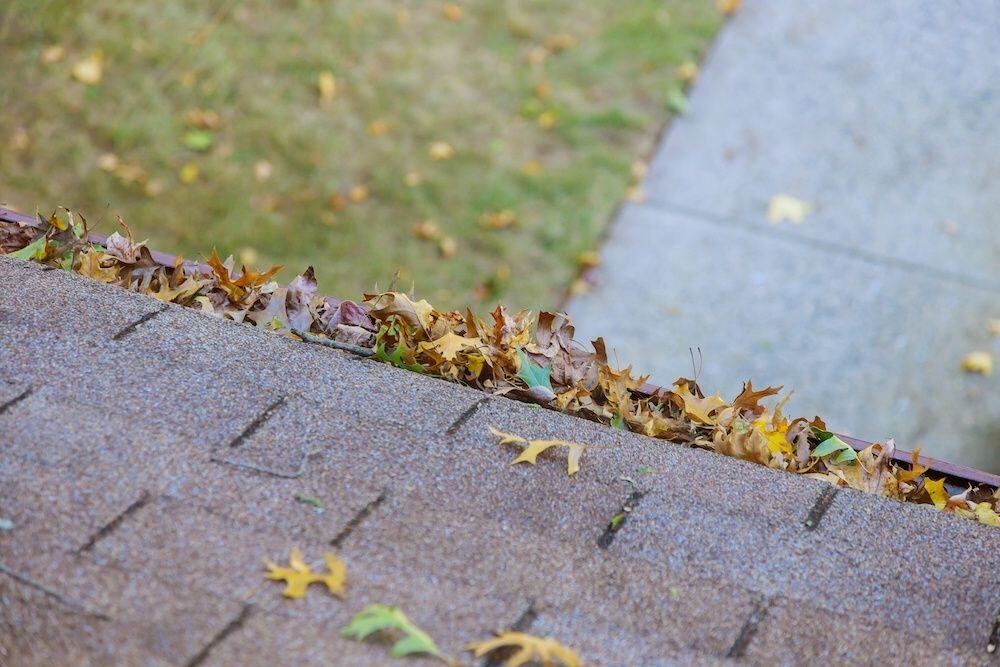How To Clean Gutters + Gutter and Downspout Maintenance Tips
September 25th, 2024 | 3 min. read
By Sarah Etler

Learn how to clean and maintain your gutters in order to prevent long-term damage.
Proper gutter maintenance is essential for protecting your home and the concrete around it from water damage.
Clean gutters channel rainwater away from your roof, foundation, and concrete surfaces (think driveways and sidewalks), preventing issues such as basement flooding, soil erosion, and structural damage.
In this article, we’re breaking down how to clean and maintain your gutters and downspouts, including tips on managing downspout extensions to ensure optimal performance.
Why Gutter Maintenance Is So Important
Ideally, you should be cleaning your gutters twice a year – in the fall and spring – which may seem like a lot until you realize how crucial they are to protecting your home.
When gutters get clogged with debris, such as leaves, twigs, and dirt, they can overflow, leading to:
-
Foundation Problems
Excess water overflowing from clogged or undersized gutters can pool around the foundation, leak into the basement, and cause cracks that weaken the structure.
-
Roof Damage
Water can back up under shingles, leading to leaks and rot.
-
Basement Flooding
Water that’s not directed away from your house can seep into your basement, causing moisture problems, flooding, and potential mold growth.
-
Settling Concrete
The overflowing water from clogged gutters, whether in a constant stream or light, steady drips, can erode away the soil under your concrete, causing it to settle over time.
Related Resource: How To Fix Settled Concrete Slabs
-
Landscape Erosion
Overflowing gutters can erode soil and damage landscaping.
How To Clean Gutters
Cleaning your gutters is a straightforward task that can prevent many of the problems mentioned above.
Follow these steps twice a year to help ensure your gutters carry water away from your home:
1. Gather Supplies
You'll need a sturdy ladder, gloves, a gutter scoop or small trowel, a bucket or trash bag, and a garden hose.
You can also use a leafblower fit with an extension kit to reach up and blow out the debris from the gutters (if they aren’t covered by gutter guards).
2. Position Your Ladder Properly
Position your ladder on a stable surface and always maintain three points of contact: two hands and one foot, or two feet and one hand. Consider using a ladder stabilizer for added safety.
3. Remove Debris
Start at the downspout end and work your way towards the other end of the gutter. Use your hands or a scooping tool to remove leaves, twigs, and other debris, placing them in your bucket or trash bag.
Remove the downspout strainer and clear any dirt or debris that may be stuck. Don’t forget to replace the strainer when you are finished.
4. Flush the Gutters
After removing the bulk of the debris, use a garden hose to flush out any remaining dirt. This also helps to check for proper water flow and identify any leaks.
5. Check for Damage
While cleaning, inspect your gutters for any signs of damage, such as cracks, rust, or loose brackets. Repair or replace damaged sections as needed.
How To Maintain Downspout Extensions
Downspout extensions help to carry water further away from your home, protecting your foundation, concrete, and landscaping. Here are some tips for maintaining them:
1. Ensure Proper Connection
Regularly check that downspout extensions are securely connected to the downspouts. Loose or disconnected extensions can lead to water pooling near the foundation.
2. Check for Blockages
Make sure the extensions are free from debris and allow for good water flow. Remove any blockages promptly to ensure they drain properly.
If your downspout leads into an underground pipe, check to make sure the water actually drains down the pipe and away by spraying water down the downspout with a hose.
If it starts backing up and overflowing from the connection point, there is a blockage in the pipe that should be removed.
3. Inspect Buried Extensions
If your downspout extensions are buried under a slab or the ground, periodically check for signs of leaks or water loss along the pipe. Look for areas where water might be surfacing or causing erosion, and address any issues immediately.
4. Maintain Proper Slope, Distance, and Direction
Ensure that the extensions slope away and direct water at least 10 feet away from the house. A storm drain, catch basin, or a garden bed that can handle the extra water are good places to direct the flow.
Read More: 6 Reasons To Install Downspout Extenders
Should You Clean and Maintain Your Gutters?
Whether you clean and maintain your gutters yourself or hire professionals to do it for you, it’s a crucial part of protecting your home from water damage.
By following the steps outlined in this guide, you can ensure that your gutters remain clear and functional and that your downspouts and extensions effectively direct water away from your property.
Here at A-1 Concrete Leveling, we’ve been lifting concrete that has settled due to overflowing gutters for over 30 years, so we know firsthand just how important it is. Check out this resource to learn more: Do I Have To Clean My Gutters?
Sarah Etler joined A-1 Concrete Leveling after receiving her Bachelor of Arts degree in English from Northern Kentucky University. As A-1's Content Marketing Manager, she works closely with industry experts to produce content that will best answer questions related to concrete repair and maintenance practices. Sarah loves living a life full of discovery and is excited every day to see what new things she can learn and share with those around her.